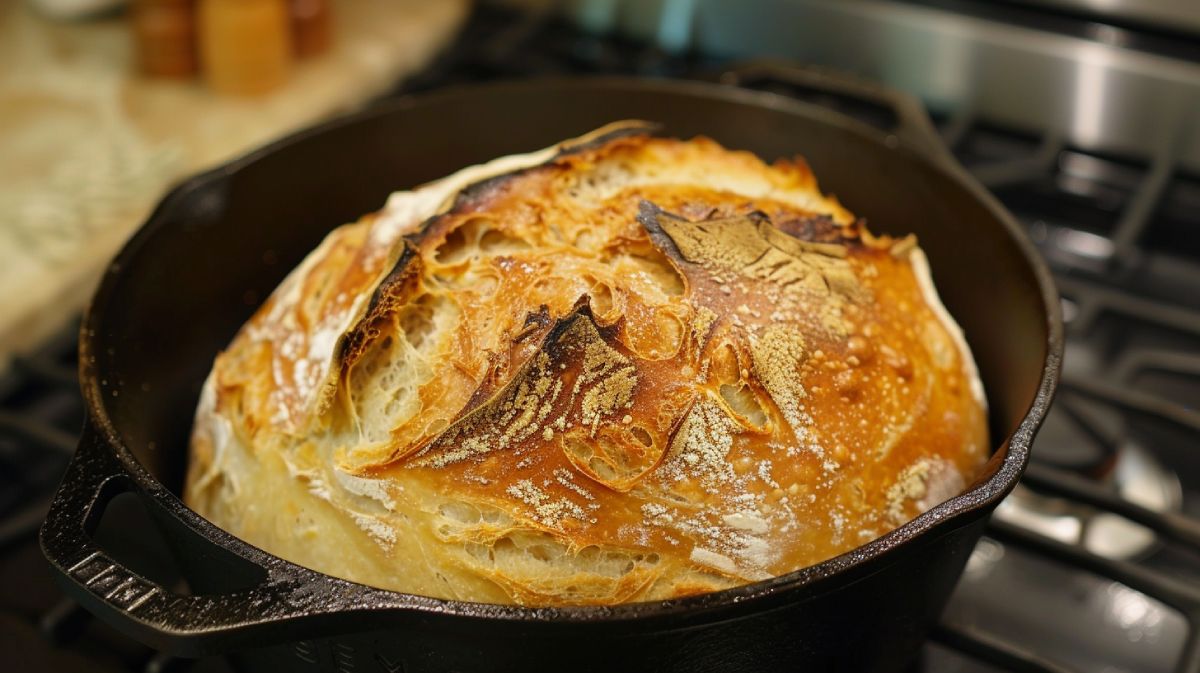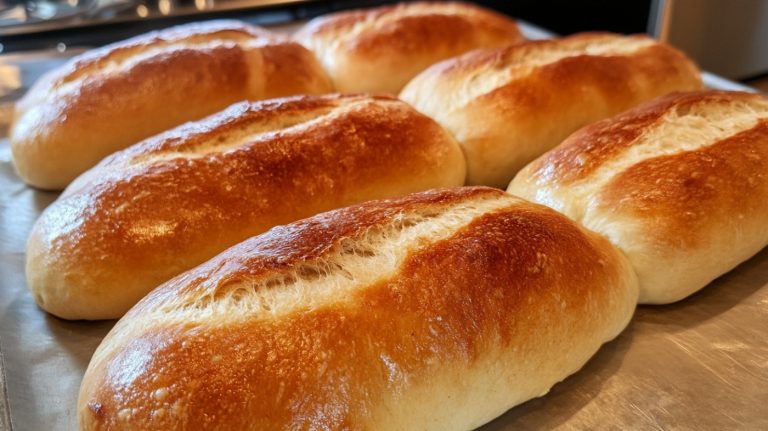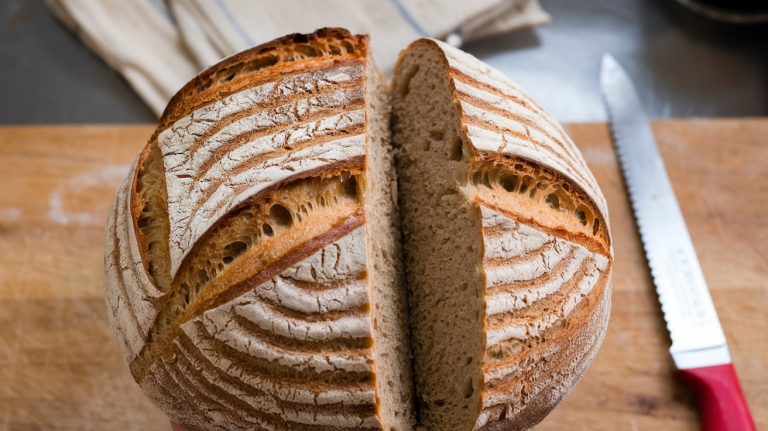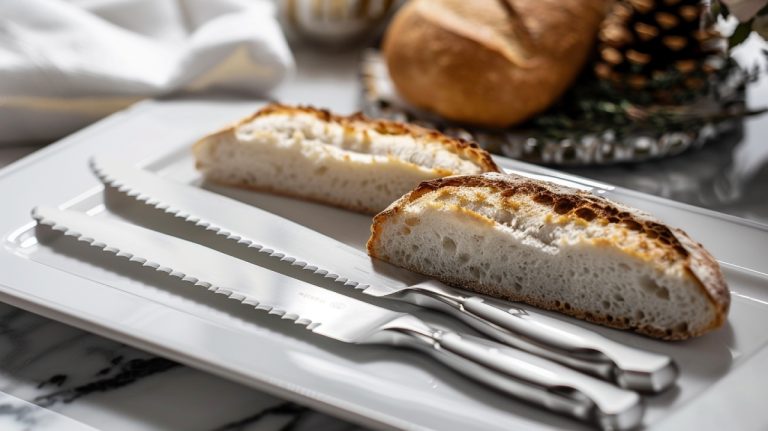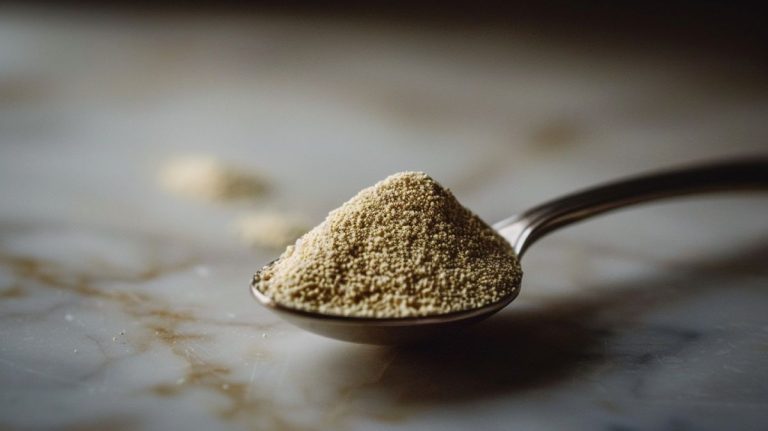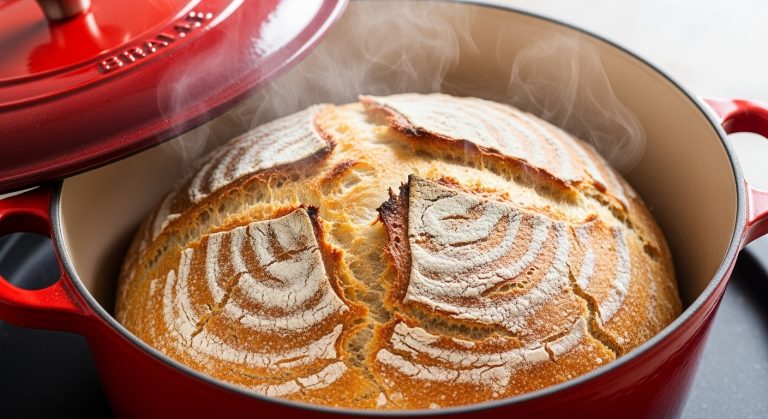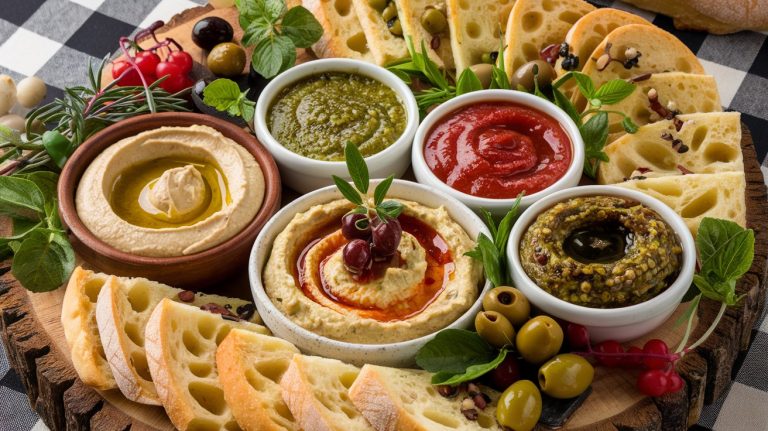Do You Need a Dutch Oven to Make Sourdough Bread?
You don’t need a Dutch oven to make sourdough bread, but it can elevate your baking game. A Dutch oven captures steam, creating the ideal environment for that perfect rise and a crispy crust.
While it simplifies the process, you can still achieve great results with alternatives. Using a cast iron skillet, baking stone, or even a simple pan of water can produce a steamy atmosphere.
Experiment with these methods to find what works for you. Ready to elevate your sourdough skills and discover more tips on perfecting your bread?
Key Takeaways
- A Dutch oven is not strictly necessary; various alternatives can create steam for baking sourdough bread effectively.
- Cast iron skillets, baking stones, and water pans can be used to generate steam without a Dutch oven.
- Proper steam retention is crucial for achieving a light, airy crumb and a crispy crust in sourdough bread.
- Preheating your oven and using creative steam generation methods can still yield excellent results without a Dutch oven.
Benefits of Using a Dutch Oven
When you choose to bake sourdough bread in a Dutch oven, you’re tapping into a tool that retains heat exceptionally well and creates an environment that mimics a professional bread oven, ensuring your loaf rises beautifully.
The heavy construction of a Dutch oven provides remarkable heat retention, allowing it to maintain high temperatures, often up to 500°F. This is essential for developing that crispy, golden-brown crust you crave.
One of the standout benefits is the steam trapped by the lid. This steam facilitates oven spring, helping your dough rise without forming a hard crust too soon. Thanks to this moisture retention, your sourdough can expand fully, creating a light and airy interior.
Additionally, using a Dutch oven simplifies the baking process, eliminating the need for complicated steam-generation methods while still achieving an ideal baking environment.
The result? Crusty sourdough with an impeccable texture that makes every bite worth it. So, if you’re ready to elevate your sourdough game, the Dutch oven is your secret weapon for a perfect loaf every time.
Alternatives to Dutch Ovens
If you don’t have a Dutch oven on hand, there are several creative alternatives that can still help you achieve that perfect sourdough loaf with a crispy crust and airy interior. Here’s a handy table of options you can consider:
| Alternative Method | Description |
|---|---|
| Cast Iron Skillet | Fill it with water or ice cubes for steam. |
| Baking Stone or Steel | Pair it with a metal pan filled with water. |
| Soaked Towels in Dish | Use rolled-up towels in boiling water for steam. |
A cast iron skillet can work wonders, providing steam that enhances your bread’s oven spring and crust. If you have a baking stone, place a separate pan of water underneath to create steam while baking. Another effective method is to soak rolled towels in boiling water and place them in a heat-safe dish; this generates steam that mimics a Dutch oven environment.
You can also preheat a pan of water or use lava rocks in the oven to achieve excellent results. With these alternatives, you can confidently bake sourdough bread without a Dutch oven, ensuring delicious outcomes every time!
Importance of Steam in Baking
Steam plays an essential role in baking your sourdough bread, allowing it to rise beautifully during oven spring.
You’ll find that maintaining a steamy environment not only helps create that irresistible golden crust but also enhances flavor through caramelization.
Whether you’re using a Dutch oven or exploring alternative methods, understanding steam’s impact can elevate your baking game.
Role of Steam
Creating the perfect sourdough bread hinges on the crucial role of steam in the baking process, as it enhances oven spring and allows your dough to rise beautifully before forming a crust. When you introduce steam into your oven, you’re delaying the crust’s setting, which helps the dough expand fully and develop that signature texture.
Here are some key aspects of steam in sourdough baking:
- Oven spring: Steam is essential for achieving that impressive rise during the first minutes of baking.
- Crust texture: It helps create a golden, blistered crust by interacting with the dough’s surface starches.
- High heat: The steam traps heat, allowing your bread to cook evenly and thoroughly.
- Versatility: You can generate steam using a Dutch oven or alternative methods like a pan of boiling water or ice cubes.
Incorporating steam into your sourdough baking not only elevates the final product but also adds an element of artistry to your homemade bread journey.
Alternative Steam Methods
Exploring alternative steam methods can greatly enhance your sourdough baking experience, ensuring that your bread rises beautifully and develops that coveted crust.
To create steam in your oven, consider using a couple of simple techniques. One effective method is to add ice cubes to a preheated Pyrex dish placed on the baking stone. As the ice melts, it generates steam, promoting oven spring and allowing your loaf to expand efficiently.
Another approach is to spritz water on your dough just before placing it in the oven. This creates an immediate moisture barrier that aids in achieving that desirable crust.
If you’re using loaf pans, you can also place a shallow pan filled with boiling water at the bottom of your oven. The high heat required for sourdough baking, typically around 450°F (232°C), helps maintain steam during the critical initial baking phase.
Impact on Crust
The presence of steam during the baking process is essential for achieving a crust that’s both crispy and beautifully golden.
When you bake sourdough, steam creates a favorable baking environment that allows your dough to expand fully, resulting in a lighter, airier loaf. If you skip steam, you may end up with a hard crust that limits your bread’s oven spring.
Here are some key benefits of steam in baking:
- Enhances oven spring: Trapped gases expand, giving your loaf a better rise.
- Promotes a light crumb: Steam helps create that airy texture we all love.
- Develops a golden brown crust: Proper steam retention allows for perfect crust coloration.
- Prevents hardening: A moist environment avoids a tough exterior that can stifle expansion.
Creating Steam Without a Dutch Oven
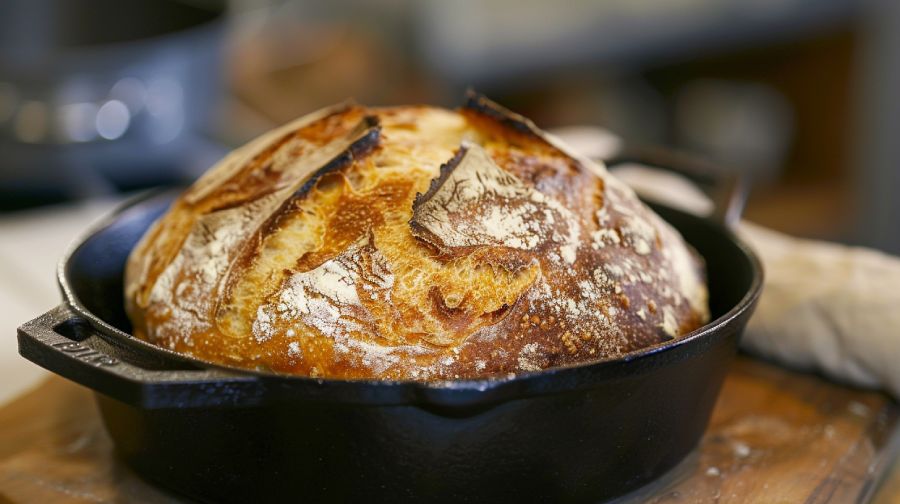
If you don’t have a Dutch oven, don’t worry—you can still create the steam your sourdough needs for a perfect rise.
Consider using a cast iron skillet or a baking dish filled with water, both of which can help generate that steamy environment in your oven.
With the right vessel and temperature adjustments, you’ll achieve a crusty loaf that rivals any baked in a Dutch oven.
Alternative Steam Methods
Creating steam in your oven can be easily achieved with several alternative methods that enhance your sourdough bread’s crust and rise.
While a Dutch oven provides an excellent environment for baking, you can still achieve that perfect oven spring with these techniques:
- Cast Iron Skillet: Place a heavy-duty skillet filled with boiling water alongside your dough.
- Metal Pan: During preheating, put a metal pan with water in the oven to create a steamy environment.
- Spritzing: Just before you place the dough in the oven, spritz it with water to boost steam production and reduce steam burns.
- Lava Rocks: Use lava rocks in a baking dish, pouring water over them right after adding your dough.
Baking Vessel Options
Exploring various baking vessel options can greatly enhance your sourdough bread experience, especially when you want to create steam without relying solely on a Dutch oven.
One excellent alternative is using a baking stone. Preheating it for at least one hour guarantees ideal heat retention, which helps achieve that perfect crispy crust.
If you have cast iron skillets on hand, they can also work wonders. Their ability to retain heat creates a conducive environment for an impressive oven spring.
Consider inverting a stock pot over your dough for a more creative approach during the initial baking phase. This traps steam, effectively mimicking the moist environment of a Dutch oven.
You can also generate steam by placing a metal pan filled with water or ice cubes on the bottom rack of your oven. This method considerably enhances the bread’s crust texture.
Alternatively, heating lava rocks or wet towels in a baking dish can produce steam, giving you even more options.
With these alternative methods, you can confidently bake sourdough bread without a Dutch oven, achieving delicious results every time.
Oven Temperature Considerations
When you aim for that perfect sourdough loaf, maintaining the right oven temperature is essential, especially if you’re relying on alternative steam methods instead of a Dutch oven.
Preheating your baking stone at around 450°F (232°C) for at least an hour creates the ideal environment for crust development.
Here are some effective ways to generate steam in your oven:
- Place a cast iron skillet filled with boiling water in the oven after you’ve put in your dough.
- Use a baking dish filled with water during the preheating phase to enhance steam.
- Spritz your dough with water before baking for added moisture and better expansion.
- Consider placing lava rocks in a shallow pan to create steam.
These methods promote oven spring and contribute to a beautifully blistered crust.
Tips for Successful Sourdough Baking
Focusing on both temperature and steam is vital to achieving a perfect sourdough loaf, as these elements dramatically influence the crust’s texture and flavor.
Preheat your oven for at least one hour to reach the ideal 450°F (232°C), ensuring the best crust development. While a Dutch oven is a fantastic option for steam retention, don’t hesitate to experiment with alternatives like a baking stone combined with a pan of water or simply sprinkling water into the oven during the first few minutes.
Consider using various baking vessels such as a cast-iron skillet or a loaf pan; each can produce delightful results when utilized correctly.
Scoring your dough before baking is another important step—it allows for controlled expansion, leading to improved oven spring and enhancing the overall texture and appearance of your sourdough bread.
Frequently Asked Questions
Can I Bake Sourdough Without a Dutch Oven?
Absolutely, you can bake sourdough without a Dutch oven! Try using a baking stone with steam, a cast-iron skillet, or even a loaf pan. These alternatives can still yield a beautifully crusty and delicious loaf.
What Can I Use Instead of a Dutch Oven for Bread?
You can use a baking stone, cast-iron skillet with water, or a baking dish filled with towels soaked in boiling water. Spritzing the dough before baking also helps create steam for a great crust!
Why Do I Need a Dutch Oven for Sourdough?
You could bake sourdough without a Dutch oven—if you enjoy dense, sad loaves! A Dutch oven traps steam, giving your bread that heavenly crust and airy crumb. Who wouldn’t want that?
Can I Bake Sourdough on a Sheet Pan?
Yes, you can bake sourdough on a sheet pan! Just create steam in the oven, score your dough for control, and bake at a high temperature for a perfect rise and crust. Enjoy your delicious bread!
No Dutch Oven? No Problem
A Dutch oven can enhance your sourdough game with its ability to trap steam, but it’s not essential.
Did you know that nearly 50% of home bakers don’t use one yet still create delicious loaves?
With a little creativity and the right techniques, you can achieve that perfect crust and airy crumb without it.
So, don’t let a lack of equipment hold you back; embrace the art of sourdough baking and enjoy the process.

